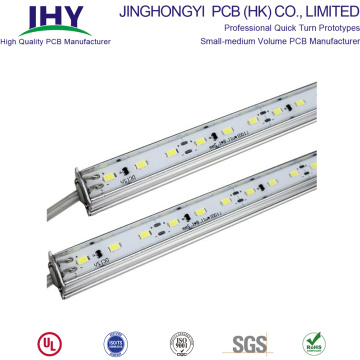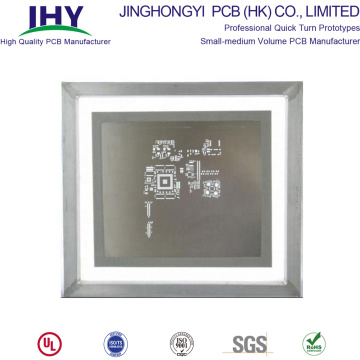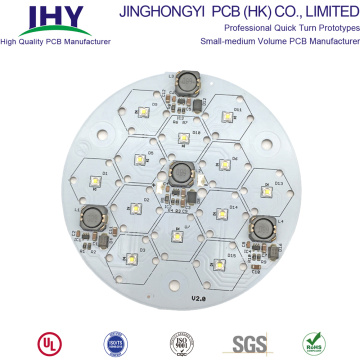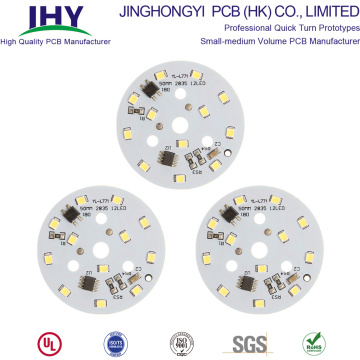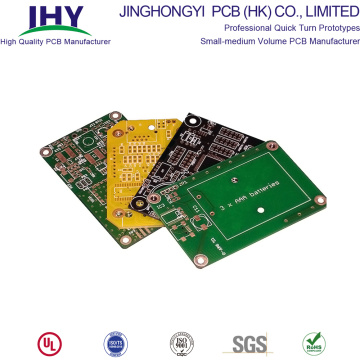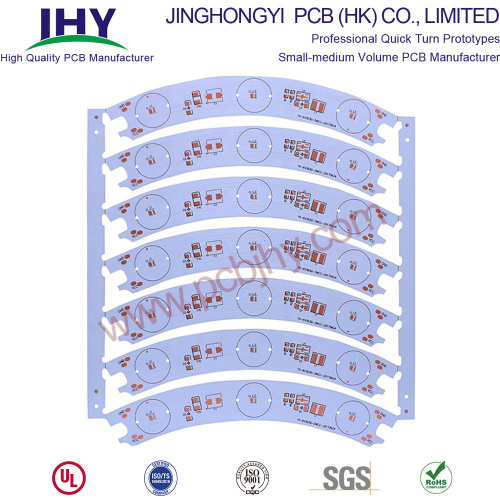
Aluminum-base Single-Sided LED PCB
- Payment Type:
- L/C, T/T, D/P, Paypal, Money Gram, Western Union
- Incoterm:
- FOB, CFR, CIF, EXW, FCA, CPT, CIP
- Min. Order:
- 1 Piece/Pieces
- Min. Order:
- 1 Piece/Pieces
- Transportation:
- Ocean, Air
Your message must be between 20 to 2000 characters
Contact Now| Place of Origin: | China |
|---|---|
| Productivity: | 10000 |
| Payment Type: | L/C,T/T,D/P,Paypal,Money Gram,Western Union |
| Incoterm: | FOB,CFR,CIF,EXW,FCA,CPT,CIP |
| Certificate: | ISO9001 |
| Transportation: | Ocean,Air |
Keywords:Advantages of Single Sided PCB, Applications of Single Sided PCB, Fabrication Process of Single Sided PCB
Jinghongyi PCB is a PCB supplier and manufacturer in Shenzhen, China, which can produce Aluminum-base Single-Sided LED PCB, street light PCB, tunnel lighting PCB, light round PCB, etc. Aluminum-based LED PCB, different from double-sided PCB, belongs to single-sided PCB, that is, PCB products with only one side of the circuit. However, the advantages of the aluminum substrate are particularly obvious. It has good thermal conductivity, electrical insulation, and machining performance. Compared with the traditional FR-4, aluminum substrate adopts the same thickness, the same linewidth, and can carry higher current. The aluminum substrate can withstand voltage up to 4500V, and the thermal conductivity is greater than 2.0. Generally, the aluminum substrate is the main part of LED PCB.
advantages of Aluminum-base Single-Sided LED PCB
1. Meet ROHS requirements;
2. More suitable for SMT process;
3. In the circuit design scheme, the thermal diffusion is effectively treated, so as to reduce the operating temperature of the module, extend the service life, and improve the power density and reliability;
4. Reduce the assembly of radiators and other hardware (including thermal interface materials), reduce product volume, and reduce hardware and assembly costs;
4. Optimize the combination of power circuit and control circuit;
5. Replace the fragile ceramic substrate to obtain better mechanical durability.
Disadvantages of Aluminum-base Single-Sided LED PCB
1. High cost.
2. At present, the mainstream can only make single panel, and it is difficult to make double-sided panel.
3. It is easy to have problems in electrical strength and withstand voltage.
Single Sided PCB Definition
Single Sided PCBs, also called Single Layer PCB, contain only one layer of conductive material and are best suited for low density designs. Single sided PCB'S have been around since the late 1950s and still dominate the world market in sheer piece volume. Single-sided printed circuit boards are easily designed and quickly manufactured. They serve as the most cost effective platform in the industry.
There are many similarities and differences between single sided PCB and double sided PCB, and we will also explain them here.
Single Sided PCB Manufacturing
One thin layer of thermally conductive but electrically insulating dielectric is laminated with copper. Soldermask is usually applied on top of the copper.

JHY PCB produces prototype, midrange and high volume Single Sided circuit boards, with a copper thickness from 1 to 20 ounces. Operating temperatures range from 130 C to 230 C. Single sided boards are available with surface finishes including Organic Surface Protectant (OSP), Immersion Silver, Tin, and Gold plating along with both leaded or lead-free Hot Air Solder Level (HASL).
Construction of Single Sided PCB
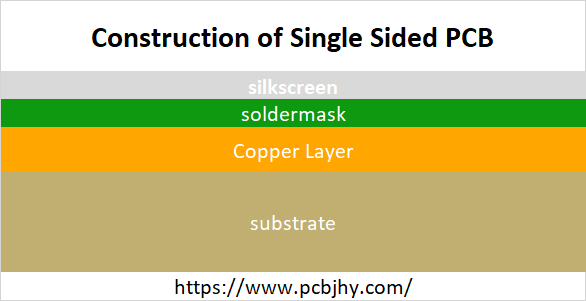
Above substrate, there lies a copper layer which provides conducting path for various components on the board. The copper thickness is different for different boards depending on your needs and requirements and is defined in ounces per square foot.
On the top of copper foil, there exists a solder mask layer. This layer is mainly used for protection and makes the copper foil insulating which helps in avoiding the conduction in case direct contact happens with some conducting material.
On the top of all layers, there exists a silkscreen layer that is mainly used for adding symbols and characters on the board so a common person can anticipate the clear understanding of the board.
Advantages of Single Layer PCB
- Ideal for simple low-density designs
- Lower cost, especially for high volume orders
- Lower probability of manufacturing issues
- Popular, common, and easily understood by most PCB manufacturers
Application of Single Sided PCB
Aluminum PCB, LED PCB used in LED lighting industry are basically Single Sided PCB.
ALTHOUGH SINGLE SIDED PCBS ARE RELATIVELY SIMPLE, THEY CAN STILL BE USED IN VERY COMPLEX DEVICES:
- Power supplies
- Relays (automotive and industrial)
- Timing circuits
- Sensor products
- LED lighting
- Radio and stereo equipment
- Packaging equipment
- Surveillance
- Calculators
- Printers
- Coffee makers
- Vending machines
- Solid state drives
- Camera systems
Single Sided PCB or Double Sided PCB?
PCBs are more suitable for project design as compared to double sided PCBs and vice versa.
Before you pick any type of PCB for your project, you must take one thing into consideration that single sided PCB layouts are more difficult to route as compared to double sided PCB, but following are the reasons why you should put an effort for making and picking single sided PCB over other PCBs.
- If you are hobbyist or students, and concerned to make PCB at home, you must know, developing single sided PCBs at home are much easier than developing double sided PCBs at home.
- As you are a manufacturer and very much interested to keep your cost down and producing a single sided PCB a most economical process. In terms of cost, producing single sided PCBs are more economical than producing double sided PCBs.
- Almost all HVAC systems make use of single sided PCBs, because they are more reliable and cost effective and don`t compromise the overall quality of the product.
- Using through hole technology in single sided PCBs still have its drawbacks and limitations because conductive layers, lines and pads stay on single side of PCB but it still is a cheap process to combine all components at one place. Multilayer PCB is also used in many applications where single sided and double sided PCBs fail to fulfill the requirements.
Related Keywords


